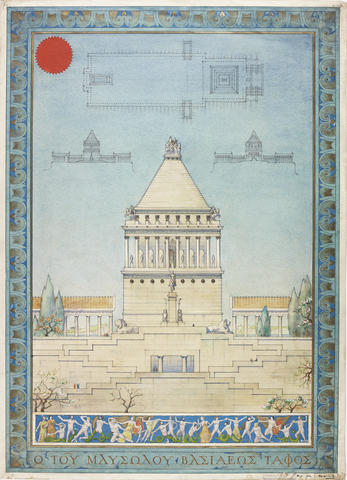License:
 This image is provided under a Creative Commons BY-NC-SA License. You can download this version for private study or non-commercial use. Our terms, conditions and copyright policy (PDF) contains further information about acceptable usage. If you are seeking permission to publish, please contact us ›
This image is provided under a Creative Commons BY-NC-SA License. You can download this version for private study or non-commercial use. Our terms, conditions and copyright policy (PDF) contains further information about acceptable usage. If you are seeking permission to publish, please contact us ›
Please click here if you would like to request a larger, high-resolution version ›
Key Information
Reference code
Title
Date(s)
- 1928-1929 (Creation)
Level of description
Item
Extent
1
Content and Structure
Scope and content
Grand design for temple building with colonnade.
Appraisal, destruction and scheduling
Accruals
System of arrangement
General Information
Name of creator
Biographical history
Richard Mervyn Noad (generally known simply as Mervyn Noad) was born on 8 September 1906 at 'Alma', Muirton Road, Perth, the son of Frederick Herbert Noad, tea merchant and his wife Jessie Mary Roberts who came from Helensburgh. He studied at Glasgow School of Architecture under Thomas Harold Hughes, concurrently serving his apprenticeship with Keppie & Henderson, from 1924 until 1929. He first ventured abroad in summer 1927 and by 1933 had visited France, Switzerland, Germany, Holland and Scandinavia. He won the A Leslie Hamilton studentship medal in 1928-29 and on the strength of his RIAS Quarterly essay on 'The influence of France on the Architecture of Scotland during the 16th century' he was offered a two-year fellowship at Clare College, Cambridge on how Scotland's vernacular could form the basis of a modern Scottish idiom, but decided against taking it up. Nevertheless he became an outlying member of the Mansfield Forbes circle and a particular friend of Ian Gordon Lindsay who thought highly of him.
Noad remained with Keppie & Henderson as a draughtsman after completing his apprenticeship, leaving in June 1930 to commence practice on his own account in Glasgow, with one full-time and one part-time draughtsman and a part-time job as evening studio instructor at Glasgow School of Art. He was admitted ARIBA later that year, his proposers being John Keppie, John Watson and Hughes. His practice took off very quickly as a result of a commission for Broadmeadows from J Percival Agnew who selected him from a number of younger architects he interviewed. This enabled him to take Alastair Frew Wallace (who appears to have subsequently changed his first name to Alexander) into partnership in 1933.
Like Lindsay, Noad had a particular interest in Scandinavia and toured the modern architecture of Norway, Sweden, Finland, Russia, Estonia, Latvia, Lithuania, Poland and Germany in 1934 following a year as editor of the RIAS Quarterly. A further tour of Italy was made about 1938-39 where he was arrested but fortunately released before the outbreak of war. In 1935 he was editor of the RIBA conference.
Both Noad and Wallace were elected FRIBA on 10 October 1950 with the same proposers - Andrew Graham Henderson, Edward Grigg Wylie and George Arthur Boswell. At that time their office was at 278 St Vincent Street.
The practice closed in 1978. Noad died in 1991.
Archival history
Custodial history
Physical Description and Conditions of Use
Conditions governing access
Conditions governing reproduction
Language of material
Script of material
Language and script notes
Physical Description
pencil, ink and watercolour on paper
Dimensions: 760 x 550 mm
Finding aids
Related Material
Existence and location of originals
Existence and location of copies
Related materials
Notes area
Alternative identifier(s)
Keywords/Tags
Subjects
Place access points
People and Organisations
Genre access points
Status
Level of detail
Processing information
Language(s)
Script(s)
Sources
Digitised item metadata
Filename
NMC_0344.jpg
Latitude
Longitude
Media type
Image
Mime-type
image/jpeg


